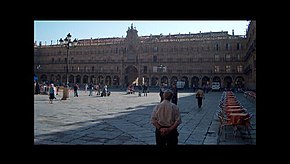Windowbox
As Windowbox a phenomenon is known that when adapting a film or a video signal to a specific aspect ratio can occur. The film image is surrounded on all sides by a thick, mostly black bar. Since a window box "wastes" a lot of image area and, in the case of digital signals, also results in a reduction in video resolution through scaling , filmmakers and device manufacturers try to prevent this phenomenon from occurring as far as possible.
Emergence
A window box is created when a film or video signal is adapted several times in succession to a foreign aspect ratio; whereby the attached edges come together to form a thick frame. A typical example is the conversion from the picture format 16: 9 to 4: 3 with a subsequent conversion back to 16: 9. If material in 16: 9 is adapted to a screen in 4: 3, black borders are attached above and below the individual images (letterbox) . If the result is then reproduced in 16: 9 at the end, margins must now be attached to the left and right (pillar box) . As a result of this, the individual images have now been "supplemented" with black borders both horizontally and vertically, resulting in the black frame described at the beginning.
Elimination
You can try to artificially remove the window box; however, a complete "liberation" of the original image without a resulting loss of quality is not possible. The most common way is scaling. Analog films can be enlarged directly as they are projected. With digital video signals, the individual images are scaled and cropped so that the window box no longer appears on the screen and the video theoretically appears again in its original size; however, this leads to a strong artifact . Some screens have an integrated function that enables such scaling without great effort.
Another (digital) possibility is to mask the actual image material and insert an alternative content in the background that has become free. A duplicate of the image content can often be seen, which has been enlarged and blurred with a soft focus filter. With this procedure, the window box is not really removed, but rather "repurposed".
Use for artistic purposes
In the area of 3D film , an intentionally created window box can create the illusion that certain elements "break out" of the canvas or the screen; by protruding over the black border.
